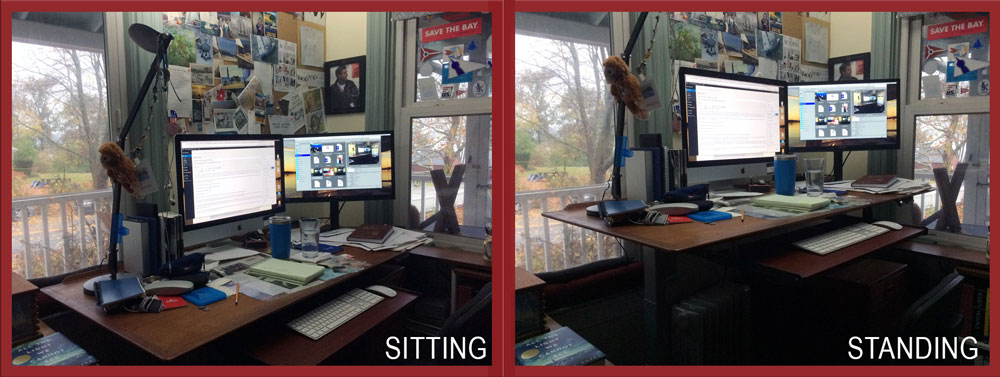In mid-October, I tweaked my back paddling by failing to adjust my habits to cooler weather. Too much sitting the day before, combined with the first chilly paddle of the fall, required more warmup time than I gave my muscles. So in protest, they tightened up—slightly out of whack. An hour after my paddle, I reached down to tie my shoes and transformed a tight discomfort to stabbing lower back pain. Yowza! The only cure was a weeklong conscious change of habits: not sitting down, not lifting anything, stretching several times a day, and supplementing World Series watching with lengthy e-stimulation (EMS) sessions*.
The not-sitting-down was the hardest part, since I had a long list of daily desk tasks. Midway through the week, I indulged a long-standing (hah) wish and ordered the parts needed to convert my mid-20th century teak desk to 21st century height variability. I won’t bore you with the installation details, but the result is amazing.
This sentence and all the preceding paragraphs were written sitting.

This sentence was written standing. Ta-DA!
(Can’t tell the difference in the writing, can you?)
In theory, I can’t tell the difference either. Same desktop, same computer screen, same keyboard and mouse; all at the same relative height and location to my eyeballs and brain.
In practice, though, that one push-button adjustment makes my mind work differently. I’m sure there are physiological explanations about blood flow and muscle activity, or maybe “expectations” about what problems we usually solve while standing up. For whatever reason, I think differently on my feet. I’m less contemplative and more efficient, which is good for cleaning out my inbox, writing a book review, or reading the blogs of others. For the woolgathering and mind meanders so crucial to first drafts, sitting still is best.
It’s taken some time to adjust, but I’m really enjoying the ability to change my perspective mid-project (or even mid-paragraph). When my back and hips start to stiffen from sitting too long, I just stand up—without interrupting my workflow. When my legs tire from standing in one place, I sit down again. Of course I still step away for water and food and pee breaks, but in between I can easily vary my posture and height while still staring at the same screen.
As devotees of standing (and walking) desks have discovered, standing doesn’t solve the sitting issue without creating a few issues of its own. The key to office worker happiness is variety, and listening to our bodies; they don’t want to stay in any single position for too long.
My back-stabbing pain took less time to heal than the Red Sox took to win the World Series, but the memory still makes me appreciate the luxury of living pain-free. I’m optimistic that changing my writing stance throughout each work day will keep my body working even better down the road. And who knows, it might also change what I write.
Now, if only I could find a way to make myself a little taller…
*For more about e-stimulation, here are two articles to read:
EMS: Why I’m a Believer (Brian Frank, founder of Hammer Nutrition, talks about why he bothers to promote and educate about EMS)
EMS: Secret Weapon to Recovery (a firefighter’s perspective on the relief it can bring to chronic back pain)
And if you’re curious, I installed a Jarvis Standing Desk Frame.